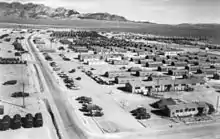Desert Rock exercises
Desert Rock was the code name of a series of exercises conducted by the US military in conjunction with atmospheric nuclear tests. They were carried out at the Nevada Proving Grounds between 1951 and 1957.

Their purpose was to train troops and gain knowledge of military maneuvers and operations on the nuclear battlefield. They included observer programs, tactical maneuvers, and damage effects tests.
Camp Desert Rock was established in 1951, 1.5 miles (2.4 kilometers) south of Camp Mercury. The site was used to billet troops and stage equipment. The camp was discontinued as an Army installation in 1964.
Summary
| Exercise | Nuclear Test Series | Date | Total DoD Participants | Tactical Maneuver Personnel |
|---|---|---|---|---|
| Desert Rock I, II, III[1] | Operation Buster–Jangle | 22 Oct. - 22 Nov. 1951 | 11,000 | 6,500 |
| Desert Rock IV[2] | Operation Tumbler–Snapper | 1 Apr. - 5 Jun. 1952 | 11,700 | 7,400 |
| Desert Rock V[3] | Operation Upshot–Knothole | 17 Mar. - 4 Jun. 1953 | 20,100 | |
| Desert Rock VI[4] | Operation Teapot | 18 Feb. - 15 May 1955 | 11,700 | 8,000 |
| Desert Rock VII, VIII[5] | Operation Plumbbob | 24 Apr. - 7 Oct. 1957 | 14,000 |
_001.jpg.webp)
_001.jpg.webp)
Desert Rock I, II, III
Observer programs were conducted at shots Dog, Sugar, and Uncle. Tactical maneuvers were conducted after shot Dog. Damage effects tests were conducted at shots Dog, Sugar, and Uncle to determine the effects of a nuclear detonation on military equipment and field fortifications.
Desert Rock IV
Observer programs were conducted at shots Charlie, Dog, Fox, and George. Tactical maneuvers were conducted after shots Charlie, Dog, and George. Psychological tests were conducted at shots Charlie, Fox, and George to determine the troops' reactions to witnessing a nuclear detonation.
Desert Rock V
Exercise Desert Rock V included troop orientation and training, a volunteer officer observer program, tactical troop maneuvers, operational helicopter tests, and damage effects evaluation.
Desert Rock VI
Observer programs were conducted at shots Wasp, Moth, Tesla, Turk, Bee, Ess, Apple 1, and Apple 2. Tactical maneuvers were conducted after shots Bee and Apple 2. Technical studies were conducted at shots Wasp, Moth, Tesla, Turk, Bee, Ess, Apple 1, Wasp Prime, Met, and Apple 2.
A test of an armored task force, RAZOR, was conducted at shot Apple 2 to demonstrate the capability of a reinforced tank battalion to seize an objective immediately after a nuclear detonation.
Desert Rock VII, VIII
Tactical maneuvers were conducted after shots Hood, Smoky, and Galileo. At shot Hood, the Marine Corps conducted a maneuver involving the use of a helicopter airlift and tactical air support. At shot Smoky, Army troops conducted an airlift assault, and at shot Galileo, Army troops were tested to determine their psychological reactions to witnessing a nuclear detonation.
See also
- Totskoye nuclear exercise of 1954, a somewhat comparable series of Soviet exercises.
Research
- Operation BUSTER-JANGLE Fact Sheet Defense Threat Reduction Agency
- Operation TUMBLER-SNAPPER Fact Sheet Defense Threat Reduction Agency
- Operation UPSHOT-KNOTHOLE Fact Sheet Defense Threat Reduction Agency
- Operation TEAPOT Fact Sheet Defense Threat Reduction Agency
- Operation PLUMBBOB Fact Sheet Defense Threat Reduction Agency
External links
| Wikimedia Commons has media related to Desert Rock exercises. |
- Camp Desert Rock Tests on YouTube
- The short film Big Picture: Atomic Battlefield is available for free download at the Internet Archive
- The short film Exercise Desert Rock (1951) is available for free download at the Internet Archive
- ACHRE report Chapter 10: Human Research at the Bomb Tests The Defense Department's Medical Experts: Advocates of Troop Maneuvers and Human Experimentation
